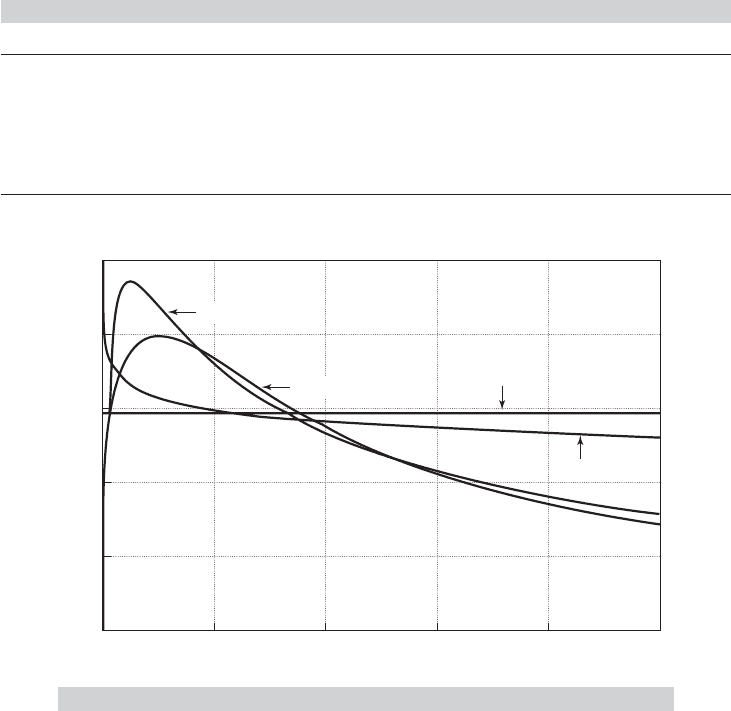Greene W.H. Econometric Analysis
Подождите немного. Документ загружается.


CHAPTER 19
✦
Limited Dependent Variables
859
TABLE 19.4
Estimates of a Tobit Model (standard errors
in parentheses)
Homoscedastic Heteroscedastic
ββα
Constant −18.28 (5.10) −4.11 (3.28) −0.47 (0.60)
Beta 10.97 (3.61) 2.22 (2.00) 1.20 (1.81)
Nonmarket 0.65 (7.41) 0.12 (1.90) 0.08 (7.55)
Number 0.75 (5.74) 0.33 (4.50) 0.15 (4.58)
Merger 0.50 (5.90) 0.24 (3.00) 0.06 (4.17)
Option 2.56 (1.51) 2.96 (2.99) 0.83 (1.70)
ln L −547.30 −466.27
Sample size 200 200
that purpose. Consider the heteroscedastic tobit model in which we specify that
σ
2
i
= σ
2
[exp(w
i
α)]
2
. (19-18)
This model is a fairly general specification that includes many familiar ones as special
cases. The null hypothesis of homoscedasticity is α = 0. (We used this specification in the
probit model in Section 17.3.7 and in the linear regression model in Section 9.7.1) Using
the BHHH estimator of the Hessian as usual, we can produce a Lagrange multiplier
statistic as follows: Let z
i
= 1ify
i
is positive and 0 otherwise,
a
i
= z
i
ε
i
σ
2
+ (1 − z
i
)
(−1)λ
i
σ
,
b
i
= z
i
ε
2
i
/σ
2
− 1
2σ
2
+ (1 − z
i
)
(x
i
β)λ
i
2σ
3
, (19-19)
λ
i
=
φ(x
i
β/σ )
1 − (x
i
β/σ )
.
The data vector is g
i
= [a
i
x
i
, b
i
, b
i
w
i
]
. The sums are taken over all observations, and
all functions involving unknown parameters (ε
i
,φ
i
,
i
, x
i
β,σ,λ
i
) are evaluated at the
restricted (homoscedastic) maximum likelihood estimates. Then,
LM = i
G[G
G]
−1
G
i = nR
2
(19-20)
in the regression of a column of ones on the K +1 + P derivatives of the log-likelihood
function for the model with multiplicative heteroscedasticity, evaluated at the estimates
from the restricted model. (If there were no limit observations, then it would reduce to
the Breusch–Pagan statistic discussed in Section 9.5.2.) Given the maximum likelihood
estimates of the tobit model coefficients, it is quite simple to compute. The statistic
has a limiting chi-squared distribution with degrees of freedom equal to the number of
variables in w
i
.
19.3.5.b Nonnormality
Nonnormality is an especially difficult problem in this setting. It has been shown that
if the underlying disturbances are not normally distributed, then the estimator based

860
PART IV
✦
Cross Sections, Panel Data, and Microeconometrics
on (19-13) is inconsistent. Research is ongoing both on alternative estimators and on
methods for testing for this type of misspecification.
13
One approach to the estimation is to use an alternative distribution. Kalbfleisch and
Prentice (2002) present a unifying treatment that includes several distributions such as
the exponential, lognormal, and Weibull. (Their primary focus is on survival analysis
in a medical statistics setting, which is an interesting convergence of the techniques in
very different disciplines.) Of course, assuming some other specific distribution does not
necessarily solve the problem and may make it worse. A preferable alternative would
be to devise an estimator that is robust to changes in the distribution. Powell’s (1981,
1984) least absolute deviations (LAD) estimator appears to offer some promise.
14
The
main drawback to its use is its computational complexity. An extensive application of
the LAD estimator is Melenberg and van Soest (1996). Although estimation in the
nonnormal case is relatively difficult, testing for this failure of the model is worthwhile
to assess the estimates obtained by the conventional methods. Among the tests that
have been developed are Hausman tests, Lagrange multiplier tests [Bera and Jarque
(1981, 1982), Bera, Jarque, and Lee (1982)], and conditional moment tests [Nelson
(1981)].
19.3.6 PANEL DATA APPLICATIONS
Extension of the familiar panel data results to the tobit model parallel the probit model,
with the attendant problems. The random effects or random parameters models dis-
cussed in Chapter 17 can be adapted to the censored regression model using simulation
or quadrature. The same reservations with respect to the orthogonality of the effects and
the regressors will apply here, as will the applicability of the Mundlak (1978) correction
to accommodate it.
Most of the attention in the theoretical literature on panel data methods for the tobit
model has been focused on fixed effects. The departure point would be the maximum
likelihood estimator for the static fixed effects model,
y
∗
it
= α
i
+ x
it
β + ε
it
,ε
it
∼ N[0,σ
2
],
y
it
= Max(0, y
it
).
However, there are no firm theoretical results on the behavior of the MLE in this
model. Intuition might suggest, based on the findings for the binary probit model, that
the MLE would be biased in the same fashion, away from zero. Perhaps surprisingly, the
results in Greene (2004) persistently found that not to be the case in a variety of model
specifications. Rather, the incidental parameters, such as it is, manifests in a downward
bias in the estimator of σ , not an upward (or downward) bias in the MLE of β. However,
this is less surprising when the tobit estimator is juxtaposed with the MLE in the linear
regression model with fixed effects. In that model, the MLE is the within-groups (LSDV)
estimator, which is unbiased and consistent. But, the ML estimator of the disturbance
variance in the linear regression model is e
LSDV
e
LSDV
/(nT ), which is biased downward
13
See Duncan (1983, 1986b), Goldberger (1983), Pagan and Vella (1989), Lee (1996), and Fernandez (1986).
14
See Duncan (1986a,b) for a symposium on the subject and Amemiya (1984). Additional references are
Newey, Powell, and Walker (1990); Lee (1996); and Robinson (1988).
CHAPTER 19
✦
Limited Dependent Variables
861
by a factor of (T −1)/T. [This is the result found in the original source on the incidental
parameters problem, Neyman and Scott (1948).] So, what evidence there is suggests
that unconditional estimation of the tobit model behaves essentially like that for the
linear regression model. That does not settle the problem, however; if the evidence is
correct, then it implies that although consistent estimation of β is possible, appropriate
statistical inference is not. The bias in the estimation of σ shows up in any estimator of
the asymptotic covariance of the MLE of β.
Unfortunately, there is no conditional estimator of β for the tobit (or truncated re-
gression) model. First differencing or taking group mean deviations does not preserve
the model. Because the latent variable is censored before observation, these transforma-
tions are not meaningful. Some progress has been made on theoretical, semiparametric
estimators for this model. See, for example, Honor`e and Kyriazidou (2000) for a survey.
Much of the theoretical development has also been directed at dynamic models where
the benign result of the previous paragraph (such as it is) is lost once again. Arellano
(2001) contains some general results. Hahn and Kuersteiner (2004) have characterized
the bias of the MLE, and suggested methods of reducing the bias of the estimators in
dynamic binary choice and censored regression models.
19.4 MODELS FOR DURATION
The leading application of the censoring models we examined in Section 19.3 is models
for durations and events. We consider the time until some kind of transition as the
duration, and the transition, itself, as the event. The length of a spell of unemployment
(until rehire or exit from the market), the duration of a strike, the amount of time until
a patient ends a health-related spell in connection with a disease or operation, and
the length of time between origination and termination (via prepayment, default, or
some other mechanism) of a mortgage are all examples of durations and transitions.
The role that censoring plays in these scenarios is that in almost all cases in which we
as analysts study duration data, some or even many of the spells we observe do not end
in transitions. For example, in studying the lengths of unemployment spells, many of
the individuals in the sample may still be unemployed at the time the study ends—the
analyst observes (or believes) that the spell will end some time after the observation
window closes. These data on spell lengths are, by construction, censored. Models of
duration will generally account explicitly for censoring of the duration data.
This section is concerned with models of duration. In some aspects, the regression-
like models we have studied, such as the discrete choice models, are the appropriate
tools. As in the previous two chapters, however, the models are nonlinear, and the famil-
iar regression methods are not appropriate. Most of this analysis focuses on maximum
likelihood estimators. In modeling duration, although an underlying regression model
is, in fact, at work, it is generally not the conditional mean function that is of interest.
More likely, as we will explore next, the objects of estimation are certain probabilities
of events, for example in the conditional probability of a transition in a given interval
given that the spell has lasted up to the point of interest. These are known as “hazard
models”—the probability is labeled the hazard function—and are a central focus of this
type of analysis.

862
PART IV
✦
Cross Sections, Panel Data, and Microeconometrics
19.4.1 MODELS FOR DURATION DATA
15
Intuition might suggest that the longer a strike persists, the more likely it is that it will
end within, say, the next week. Or is it? It seems equally plausible to suggest that the
longer a strike has lasted, the more difficult must be the problems that led to it in the
first place, and hence the less likely it is that it will end in the next short time interval.
A similar kind of reasoning could be applied to spells of unemployment or the interval
between conceptions. In each of these cases, it is not only the duration of the event, per
se, that is interesting, but also the likelihood that the event will end in “the next period”
given that it has lasted as long as it has.
Analysis of the length of time until failure has interested engineers for decades.
For example, the models discussed in this section were applied to the durability of
electric and electronic components long before economists discovered their usefulness.
Likewise, the analysis of survival times—for example, the length of survival after the
onset of a disease or after an operation such as a heart transplant—has long been a
staple of biomedical research. Social scientists have recently applied the same body of
techniques to strike duration, length of unemployment spells, intervals between con-
ception, time until business failure, length of time between arrests, length of time from
purchase until a warranty claim is made, intervals between purchases, and so on.
This section will give a brief introduction to the econometric analysis of duration
data. As usual, we will restrict our attention to a few straightforward, relatively uncom-
plicated techniques and applications, primarily to introduce terms and concepts. The
reader can then wade into the literature to find the extensions and variations. We will
concentrate primarily on what are known as parametric models. These apply familiar
inference techniques and provide a convenient departure point. Alternative approaches
are considered at the end of the discussion.
19.4.2 DURATION DATA
The variable of interest in the analysis of duration is the length of time that elapses
from the beginning of some event either until its end or until the measurement is taken,
which may precede termination. Observations will typically consist of a cross section of
durations, t
1
, t
2
,...,t
n
. The process being observed may have begun at different points
in calendar time for the different individuals in the sample. For example, the strike
duration data examined in Example 19.8 are drawn from nine different years.
Censoring is a pervasive and usually unavoidable problem in the analysis of du-
ration data. The common cause is that the measurement is made while the process is
ongoing. An obvious example can be drawn from medical research. Consider analyzing
the survival times of heart transplant patients. Although the beginning times may be
known with precision, at the time of the measurement, observations on any individuals
who are still alive are necessarily censored. Likewise, samples of spells of unemployment
drawn from surveys will probably include some individuals who are still unemployed
at the time the survey is taken. For these individuals, duration, or survival, is at least the
15
There are a large number of highly technical articles on this topic, but relatively few accessible sources for
the uninitiated. A particularly useful introductory survey is Kiefer (1988), upon which we have drawn heavily
for this section. Other useful sources are Kalbfleisch and Prentice (2002), Heckman and Singer (1984a),
Lancaster (1990), Florens, Fougere, and Mouchart (1996) and Cameron and Trivedi (2005, Chapters 17–19).

CHAPTER 19
✦
Limited Dependent Variables
863
observed t
i
, but not equal to it. Estimation must account for the censored nature of the
data for the same reasons as considered in Section 19.3. The consequences of ignoring
censoring in duration data are similar to those that arise in regression analysis.
In a conventional regression model that characterizes the conditional mean and
variance of a distribution, the regressors can be taken as fixed characteristics at the
point in time or for the individual for which the measurement is taken. When measuring
duration, the observation is implicitly on a process that has been under way for an
interval of time from zero to t. If the analysis is conditioned on a set of covariates (the
counterparts to regressors) x
t
, then the duration is implicitly a function of the entire
time path of the variable x(t), t = (0, t), which may have changed during the interval.
For example, the observed duration of employment in a job may be a function of the
individual’s rank in the firm. But their rank may have changed several times between
the time they were hired and when the observation was made. As such, observed rank
at the end of the job tenure is not necessarily a complete description of the individual’s
rank while they were employed. Likewise, marital status, family size, and amount of
education are all variables that can change during the duration of unemployment and
that one would like to account for in the duration model. The treatment of time-varying
covariates is a considerable complication.
16
19.4.3 A REGRESSION-LIKE APPROACH: PARAMETRIC
MODELS OF DURATION
We will use the term spell as a catchall for the different duration variables we might
measure. Spell length is represented by the random variable T. A simple approach to
duration analysis would be to apply regression analysis to the sample of observed spells.
By this device, we could characterize the expected duration, perhaps conditioned on
a set of covariates whose values were measured at the end of the period. We could
also assume that conditioned on an x that has remained fixed from T = 0toT = t, t
has a normal distribution, as we commonly do in regression. We could then characterize
the probability distribution of observed duration times. But, normality turns out not to
be particularly attractive in this setting for a number of reasons, not least of which is
that duration is positive by construction, while a normally distributed variable can take
negative values. (Lognormality turns out to be a palatable alternative, but it is only one
among a long list of candidates.)
19.4.3.a Theoretical Background
Suppose that the random variable T has a continuous probability distribution f (t),
where t is a realization of T. The cumulative probability is
F(t) =
'
t
0
f (s) ds = Prob(T ≤ t).
We will usually be more interested in the probability that the spell is of length at least
t, which is given by the survival function,
S(t) = 1 − F(t) = Prob(T ≥ t).
16
See Petersen (1986) for one approach to this problem.

864
PART IV
✦
Cross Sections, Panel Data, and Microeconometrics
Consider the question raised in the introduction: Given that the spell has lasted until
time t, what is the probability that it will end in the next short interval of time, say, t?
It is
l(t,t) = Prob(t ≤ T ≤ t + t | T ≥ t).
A useful function for characterizing this aspect of the distribution is the hazard rate,
λ(t) = lim
t→0
Prob(t ≤ T ≤ t + t |T ≥ t)
t
= lim
t→0
F(t + t) − F(t)
tS(t)
=
f (t)
S(t)
.
Roughly, the hazard rate is the rate at which spells are completed after duration t, given
that they last at least until t. As such, the hazard function gives an answer to our original
question.
The hazard function, the density, the CDF, and the survival function are all related.
The hazard function is
λ(t) =
−d ln S(t)
dt
,
so
f (t) = S(t)λ(t).
Another useful function is the integrated hazard function
(t) =
'
t
0
λ(s) ds,
for which
S(t) = e
−(t)
,
so
(t) =−ln S(t).
The integrated hazard function is generalized residual in this setting. [See Chesher and
Irish (1987) and Example 19.8.]
19.4.3.b Models of the Hazard Function
For present purposes, the hazard function is more interesting than the survival rate
or the density. Based on the previous results, one might consider modeling the hazard
function itself, rather than, say, modeling the survival function and then obtaining the
density and the hazard. For example, the base case for many analyses is a hazard rate
that does not vary over time. That is, λ(t) is a constant λ. This is characteristic of a
process that has no memory; the conditional probability of “failure” in a given short
interval is the same regardless of when the observation is made. Thus,
λ(t) = λ.
From the earlier definition, we obtain the simple differential equation,
−d ln S(t)
dt
= λ.
The solution is
ln S(t) = k − λt,

CHAPTER 19
✦
Limited Dependent Variables
865
or
S(t) = Ke
−λt
,
where K is the constant of integration. The terminal condition that S(0) = 1 implies
that K = 1, and the solution is
S(t) = e
−λt
.
This solution is the exponential distribution, which has been used to model the time
until failure of electronic components. Estimation of λ is simple, because with an expo-
nential distribution, E [t] = 1/λ. The maximum likelihood estimator of λ would be the
reciprocal of the sample mean.
A natural extension might be to model the hazard rate as a linear function, λ(t) =
α + βt. Then (t) = αt +
1
2
βt
2
and f (t) = λ(t)S(t) = λ(t) exp[−(t)]. To avoid a
negative hazard function, one might depart from λ(t) = exp[g(t, θ)], where θ is a vector
of parameters to be estimated. With an observed sample of durations, estimation of
α and β is, at least in principle, a straightforward problem in maximum likelihood.
[Kennan (1985) used a similar approach.]
A distribution whose hazard function slopes upward is said to have positive duration
dependence. For such distributions, the likelihood of failure at time t, conditional upon
duration up to time t, is increasing in t. The opposite case is that of decreasing hazard
or negative duration dependence. Our question in the introduction about whether the
strike is more or less likely to end at time t given that it has lasted until time t can be
framed in terms of positive or negative duration dependence. The assumed distribution
has a considerable bearing on the answer. If one is unsure at the outset of the analysis
whether the data can be characterized by positive or negative duration dependence,
then it is counterproductive to assume a distribution that displays one characteristic
or the other over the entire range of t. Thus, the exponential distribution and our sug-
gested extension could be problematic. The literature contains a cornucopia of choices
for duration models: normal, inverse normal [inverse Gaussian; see Lancaster (1990)],
lognormal, F, gamma, Weibull (which is a popular choice), and many others.
17
To il-
lustrate the differences, we will examine a few of the simpler ones. Table 19.5 lists the
hazard functions and survival functions for four commonly used distributions. Each in-
volves two parameters, a location parameter λ, and a scale parameter, p. [Note that in
the benchmark case of the exponential distribution, λ is the hazard function. In all other
cases, the hazard function is a function of λ, p, and, where there is duration dependence,
t as well. Different authors, for example, Kiefer (1988), use different parameterizations
of these models. We follow the convention of Kalbfleisch and Prentice (2002).]
All these are distributions for a nonnegative random variable. Their hazard func-
tions display very different behaviors, as can be seen in Figure 19.7. The hazard function
for the exponential distribution is constant, that for the Weibull is monotonically in-
creasing or decreasing depending on p, and the hazards for lognormal and loglogistic
distributions first increase and then decrease. Which among these or the many alterna-
tives is likely to be best in any application is uncertain.
17
Three sources that contain numerous specifications are Kalbfleisch and Prentice (2002), Cox and Oakes
(1985), and Lancaster (1990).

866
PART IV
✦
Cross Sections, Panel Data, and Microeconometrics
TABLE 19.5
Survival Distributions
Distribution Hazard Function, λ(t) Survival Function, S(t)
Exponential λ, S(t) = e
−λt
Weibull λp(λt)
p−1
, S(t) = e
−(λt)
p
Lognormal f (t) = (p/t)φ[p ln(λt)] S(t) = [−p ln(λt)]
[ln t is normally distributed with mean −ln λ and standard deviation 1/ p.]
Loglogistic λ(t) = λp(λt)
p−1
/[1 +(λt)
p
], S(t) = 1/[1 +(λt)
p
]
[ln t has a logistic distribution with mean −ln λ and variance π
2
/(3p
2
).]
0
0
0.040
0.032
0.024
0.016
0.008
10020 40
Days
Exponential
Weibull
60 80
Lognormal
Loglogistic
FIGURE 19.7
Parametric Hazard Functions.
19.4.3.c Maximum Likelihood Estimation
The parameters λ and p of these models can be estimated by maximum likelihood.
For observed duration data, t
1
, t
2
,...,t
n
, the log-likelihood function can be formulated
and maximized in the ways we have become familiar with in earlier chapters. Censored
observations can be incorporated as in Section 19.3 for the tobit model. [See (19-13).]
As such,
ln L(θ ) =
uncensored
observations
ln f (t |θ) +
censored
observations
ln S(t |θ),
where θ = (λ, p). For some distributions, it is convenient to formulate the log-likelihood
function in terms of f (t) = λ(t)S(t) so that
ln L =
uncensored
observations
ln λ(t |θ ) +
all
observations
ln S(t |θ).

CHAPTER 19
✦
Limited Dependent Variables
867
Inference about the parameters can be done in the usual way. Either the BHHH estima-
tor or actual second derivatives can be used to estimate asymptotic standard errors for
the estimates. The transformation w = p(ln t +ln λ) for these distributions greatly facil-
itates maximum likelihood estimation. For example, for the Weibull model, by defining
w = p(ln t +ln λ), we obtain the very simple density f (w) = exp[w −exp(w)] and sur-
vival function S(w) = exp(−exp(w)).
18
Therefore, by using ln t instead of t, we greatly
simplify the log-likelihood function. Details for these and several other distributions
may be found in Kalbfleisch and Prentice (2002, pp. 68–70). The Weibull distribution is
examined in detail in the next section.
19.4.3.d Exogenous Variables
One limitation of the models given earlier is that external factors are not given a role
in the survival distribution. The addition of “covariates” to duration models is fairly
straightforward, although the interpretation of the coefficients in the model is less so.
Consider, for example, the Weibull model. (The extension to other distributions will be
similar.) Let
λ
i
= e
−x
i
β
,
where x
i
is a constant term and a set of variables that are assumed not to change from
time T = 0 until the “failure time,” T = t
i
. Making λ
i
a function of a set of regressors
is equivalent to changing the units of measurement on the time axis. For this reason,
these models are sometimes called accelerated failure time models. Note as well that
in all the models listed (and generally), the regressors do not bear on the question of
duration dependence, which is a function of p.
Let σ = 1/p and let δ
i
= 1 if the spell is completed and δ
i
= 0 if it is censored. As
before, let
w
i
= p ln(λ
i
t
i
) =
(ln t
i
− x
i
β)
σ
,
and denote the density and survival functions f (w
i
) and S(w
i
). The observed random
variable is
ln t
i
= σ w
i
+ x
i
β.
The Jacobian of the transformation from w
i
to ln t
i
is dw
i
/dlnt
i
= 1/σ , so the density
and survival functions for ln t
i
are
f (ln t
i
|x
i
, β,σ) =
1
σ
f
ln t
i
− x
i
β
σ
, and S(ln t
i
|x
i
, β,σ) = S
ln t
i
− x
i
β
σ
.
The log-likelihood for the observed data is
ln L(β,σ |data) =
n
i=1
[δ
i
ln f (ln t
i
|x
i
, β,σ)+ (1 − δ
i
) ln S(ln t
i
|x
i
, β,σ)].
18
The transformation is exp(w) = (λt)
p
so t = (1/λ)[exp(w)]
1/ p
. The Jacobian of the transformation is
dt/dw = [exp(w)]
1/ p
/(λp). The density in Table 19.5 is λp[exp(w)]
−(1/ p)−1
[exp(−exp(w))]. Multiplying by
the Jacobian produces the result, f (w) = exp[w − exp(w)]. The survival function is the antiderivative,
[exp(−exp(w))].

868
PART IV
✦
Cross Sections, Panel Data, and Microeconometrics
For the Weibull model, for example (see footnote 18),
f (w
i
) = exp(w
i
− e
w
i
),
and
S(w
i
) = exp(−e
w
i
).
Making the transformation to ln t
i
and collecting terms reduces the log-likelihood to
ln L(β,σ |data) =
i
δ
i
ln t
i
− x
i
β
σ
− ln σ
− exp
ln t
i
− x
i
β
σ
.
(Many other distributions, including the others in Table 19.5, simplify in the same way.
The exponential model is obtained by setting σ to one.) The derivatives can be equated to
zero using the methods described in Section E.3. The individual terms can also be used to
form the BHHH estimator of the asymptotic covariance matrix for the estimator.
19
The
Hessian is also simple to derive, so Newton’s method could be used instead.
20
Note that the hazard function generally depends on t, p, and x. The sign of an
estimated coefficient suggests the direction of the effect of the variable on the hazard
function when the hazard is monotonic. But in those cases, such as the loglogistic, in
which the hazard is nonmonotonic, even this may be ambiguous. The magnitudes of
the effects may also be difficult to interpret in terms of the hazard function. In a few
cases, we do get a regression-like interpretation. In the Weibull and exponential models,
E [t |x
i
] = exp(x
i
β)[(1/ p) + 1], whereas for the lognormal and loglogistic models,
E [ln t |x
i
] = x
i
β. In these cases, β
k
is the derivative (or a multiple of the derivative)
of this conditional mean. For some other distributions, the conditional median of t
is easily obtained. Numerous cases are discussed by Kiefer (1988), Kalbfleisch and
Prentice (2002), and Lancaster (1990).
19.4.3.e Heterogeneity
The problem of heterogeneity in duration models can be viewed essentially as the result
of an incomplete specification. Individual specific covariates are intended to incorpo-
rate observation specific effects. But if the model specification is incomplete and if
systematic individual differences in the distribution remain after the observed effects
are accounted for, then inference based on the improperly specified model is likely to
be problematic. We have already encountered several settings in which the possibility
of heterogeneity mandated a change in the model specification; the fixed and random
effects regression, logit, and probit models all incorporate observation-specific effects.
Indeed, all the failures of the linear regression model discussed in the preceding chap-
ters can be interpreted as a consequence of heterogeneity arising from an incomplete
specification.
There are a number of ways of extending duration models to account for het-
erogeneity. The strictly nonparametric approach of the Kaplan–Meier estimator (see
Section 19.4.4) is largely immune to the problem, but it is also rather limited in how
19
Note that the log-likelihood function has the same form as that for the tobit model in Section 19.3.2. By
just reinterpreting the nonlimit observations in a tobit setting, we can, therefore, use this framework to apply
a wide range of distributions to the tobit model. [See Greene (1995a) and references given therein.]
20
See Kalbfleisch and Prentice (2002) for numerous other examples.
